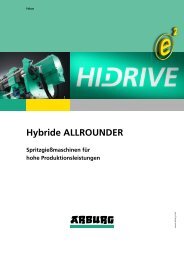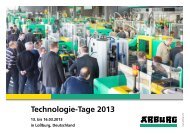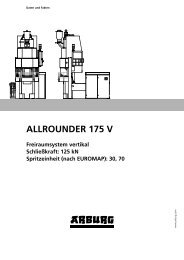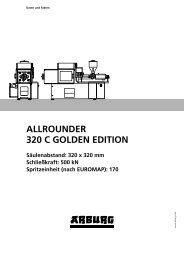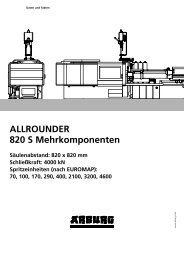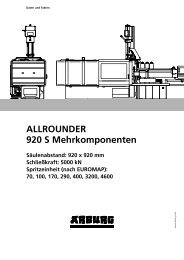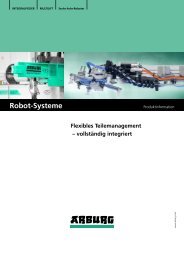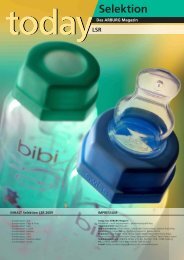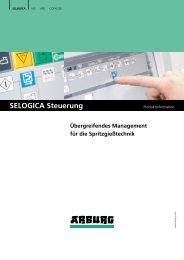GB - Arburg
GB - Arburg
GB - Arburg
Create successful ePaper yourself
Turn your PDF publications into a flip-book with our unique Google optimized e-Paper software.
design<br />
from when a grain of granulate enters<br />
the plasticising cylinder to when it exits<br />
through the nozzle. The dwell time specific<br />
to plastic ranges from approx. 30 to<br />
600 seconds for standard plastics and 60<br />
to 600 seconds for technical plastics. This<br />
defines the limit values for maximum possible<br />
and minimum necessary melting capability<br />
of an injection unit. However, it is<br />
recommended not to use the full melting<br />
capability of an injection unit, but rather<br />
to utilise the optimum working range between<br />
20 and 80 per cent of the total capacity.<br />
Based on material throughput, it is also<br />
very easy to determine which injection<br />
unit sizes come into question (graph, top).<br />
The material throughput of a specific application<br />
is dependent on the shot weight<br />
and cycle time of the injection process. As<br />
illustrated by the lower graph indicating<br />
specific energy consumption, efficiency<br />
can be improved by a factor of four or<br />
more by observing these recommendations.<br />
The higher the utilisation of an injection<br />
unit, the greater its efficiency and<br />
the lower the specific energy consumption.<br />
High utilisation of the injection unit<br />
is helped by short cycle times (example:<br />
packaging item). Applications with long<br />
cycle times, for example, necessarily result<br />
in a higher specific energy consumption<br />
(example: thick-walled optical parts).<br />
In order to ensure the greatest possible<br />
flexibility when adapting the machine size<br />
to the injection process, ARBURG offers<br />
a comprehensive catalogue of modular<br />
machine elements and technologies. Of<br />
particular interest here are the varied combination<br />
options with regard to clamping<br />
units (clamping forces and distances<br />
between tie bars) together with injection<br />
units and drive technologies. In this way,<br />
an ideal combination in terms of energy<br />
can be put together, even under unfavourable<br />
conditions. This flexibility is particularly<br />
useful where the required machine<br />
size does not allow for a fully-electric and<br />
consequently energy-optimised drive.<br />
However, besides the injection moulding<br />
machine, moulds and temperature<br />
control devices also exert considerable influence<br />
on the energy consumption of an<br />
injection moulding process. For example,<br />
when moulds have temperature control, it<br />
is extremely important to provide appropriate<br />
insulation for the mould. Otherwise,<br />
as with a poorly insulated house, large<br />
Photo: FLIR Systems<br />
Optimum working range of injection<br />
units in relation to material throughput<br />
(graph, top).Specific energy consump-<br />
tion as a function of material throughput<br />
(graph, bottom).<br />
quantities of heat will simply be discarded,<br />
unutilised, around the injection moulding<br />
machine or into the environment. Insulation<br />
measures on hot runners also help<br />
to save energy. Another important point<br />
is that temperature control devices must<br />
be designed for the moulds’ specific temperature<br />
requirements.



